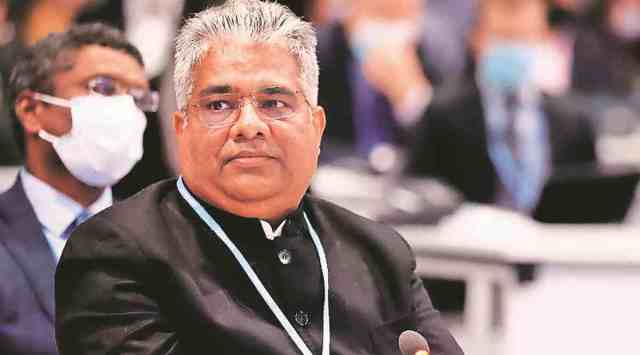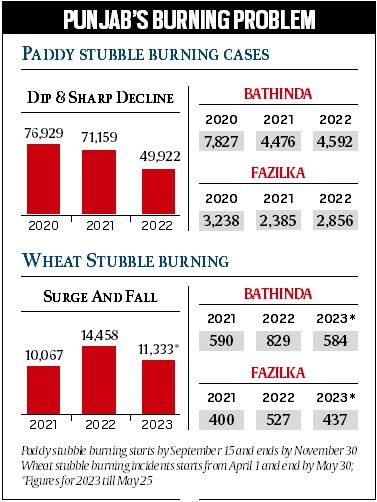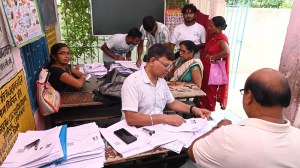Farm fires in Punjab down 31%, but Centre wants action against two DCs for ‘lapses’
The Centre, in a letter to Punjab Chief Secretary Vijay Kumar Janjua, has pointed out that Bathinda and Fazilka were among the few districts that recorded an increment in stubble-burning incidents.
 Union Environment Minister Bhupender Yadav wants the responsibility to be fixed on both deputy commissioners for the increment in stubble fires. (File)
Union Environment Minister Bhupender Yadav wants the responsibility to be fixed on both deputy commissioners for the increment in stubble fires. (File) While recording a 31.5 per cent reduction in stubble fires in the 2022 paddy season as compared to 2021, the Ministry of Environment, Forest and Climate Change has written to the Punjab government to take action against the deputy commissioners (DC) of Fazilka and Bathinda for an increase in stubble fire incidents in their districts.
Showkat Ahmad Parray was the deputy commissioner of Bathinda during this period, while Himanshu Aggarwal was the deputy commissioner of Fazilka.
In a communication to Punjab Chief Secretary Vijay Kumar Janjua, Additional Secretary, Government of India, Naresh Pal Gangwar has said that the Union Environment Minister Bhupender Yadav wants the responsibility to be fixed on both deputy commissioners for the increment in stubble fires in the September 15-November 30 period in 2022 as it is “indicative of lapses and weak monitoring by the district administration”.
 Punjab has been accused of causing pollution in the Delhi-NCR region owing to stubble fires.
Punjab has been accused of causing pollution in the Delhi-NCR region owing to stubble fires.
The communication followed a review meeting on April 26 on air quality management of Delhi-NCR and adjoining areas. Yadav said that the district magistrates or deputy commissioners need to take necessary action for the implementation of state action plans on control of stubble fires.
The letter states, “It is to state that as a result of concerted efforts of the various stakeholders, paddy crop residue burning events in Punjab, Haryana, Delhi and NCR districts of UP and Rajasthan, during the period from September 15 to November 30, 2022 registered a significant overall reduction of 31.5 per cent as compared to the corresponding period in 2021. In spite of this notable reduction in the stubble burning incidents, there are few districts in NCR region which have recorded a noteworthy increment in the burning incidents and such districts include Bathinda and Fazilka from Punjab, Yamuna Nagar from Haryana and Bulandshahar from UP.”
In 2022, a total of 49,922, paddy stubble burning cases were recorded in Punjab against 71,159 and 76,929 cases in 2021 and 2020, respectively. In Punjab, the paddy stubble burning season starts by September 15 and ends November 30. Bathinda had reported 4,592 paddy stubble burning cases in 2022, which was 116 more than 4,476 recorded in 2021 but more than 3,200 less than 7,827 farm fires recorded in the district till November 30, 2020.Similarly, Fazilka reported 2,856 paddy stubble fires, up from 2,385 in 2021, but lesser than 3,238 cases reported in 2020.
As per the officials, the role of district magistrates or deputy commissioners is vital towards the effective reduction of stubble burning. Therefore, an increase in active fire count in districts is indicative of lapses and weak monitoring on the part of district administration in general, and the district magistrate or deputy commissioner in particular.
Punjab has been accused of causing pollution in the Delhi-NCR region owing to stubble fires. The state has recorded 11,333 stubble burning cases till May 25 post wheat harvesting. This year, highest number of wheat stubble burning cases have been recorded in Moga (1010) followed by Gurdaspur (950) and Ludhiana (886). Bathinda recorded 584 and Fazilka 437 fire incidents during the period. Last year, 14,458 wheat stubble-burning cases were recorded till May 25, nearly 40 per cent more than 10,067 cases in the same period in 2021. Bathinda and Fazilka had recorded 829 and 527 cases, respectively in 2022 against 590 and 400 burning incidents recorded in 2021
The government had last year launched a sensitisation drive to check the incidence. However, the government has also been seeking a bonus from the Centre for farmers not resorting to fires.
Last year, Aam Aadmi Party governments in Punjab and Delhi had offered to pay Rs 500 per acre each to the farmers and sought a bonus of Rs 1,500 per acre from the Centre but the latter had refused.







